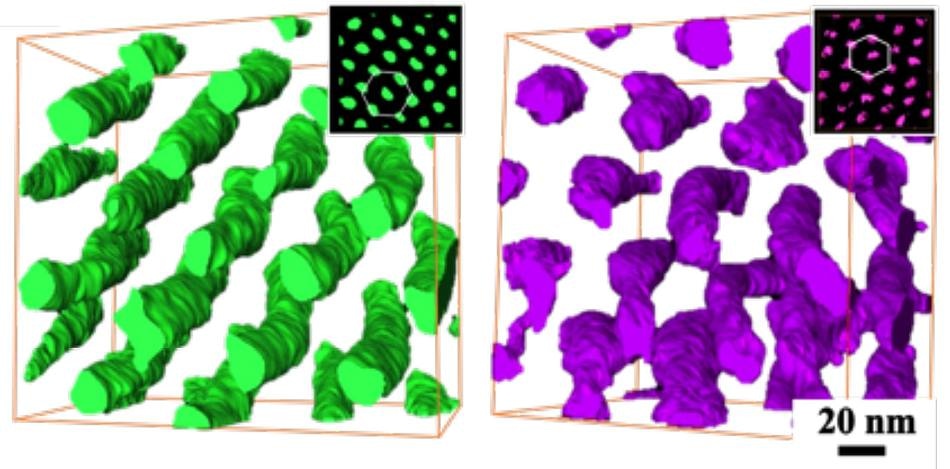Feb 12 2019
The above follows the same as below. That appears to be a working principle for molecules that begin with a basic chirality—or “handedness”—and the same phenomenon is followed as they integrate into bigger structures.
 A reconstruction of block copolymers as seen through an electron microscope clearly shows how they follow the chirality, or handedness, established by their basic molecules and grow into spiraling structures that twist left or right. Their controllable “handed-ness” and tunability could lead to materials with unique optical qualities. (Image credit: Rong-Ming Ho)
A reconstruction of block copolymers as seen through an electron microscope clearly shows how they follow the chirality, or handedness, established by their basic molecules and grow into spiraling structures that twist left or right. Their controllable “handed-ness” and tunability could lead to materials with unique optical qualities. (Image credit: Rong-Ming Ho)
An international group that included Edwin Thomas, a materials scientist at Rice University, extracted a new, essential detail from its bottom-up creation of numerous block copolymers—synthetic materials that are naturally self-assembled from small building blocks.
The researchers discovered that the left or right chirality set up by the tiniest building blocks (monomers) of the polymer duplicated itself as the microscopic material gathered to form larger scale spiraling structures similar to those normally found in nature—for example, in helical DNA—and could allow the formation of materials with exceptional properties.
From a properties standpoint, chirality is pretty big for optics. The hope is that we can control self-assembly of chiral entities to make super-chiral entities 10 or 100 times bigger so that they are able to interact with visible or even infrared light.
Edwin Thomas, Materials Scientist, Rice University
A paper published in the Proceedings of the National Academy of Sciences is focussed on the discovery headed by the experimental colleagues of Rice professor in Taiwan.
Thomas and his colleagues have devoted several years to develop expertise in block copolymers, a class of metamaterials that are capable of assembling themselves into various distinct patterns, including alternating layers. A single alternating layer copolymer developed by them was able to absorb the energy of a micro-scale bullet, while another copolymer produced a color-changing film able to serve as a sensor in food packaging that could identify spoilage, and another that may be used to reversibly write in color on normal paper.
Thomas observed the significance of chirality in nature, particularly in drug design, where a left-handed molecule can prove to be a savior, whereas the same but right-handed molecule can be poisonous. According to him, chiral-specific copolymers that imitate nature could also turn into tough-but-flexible compounds with inimitable, tunable properties.
Researchers at the National Tsing Hua and National Chung Cheng universities in Taiwan developed a series of polymer cylinders from monomers and demonstrated that the cylinders twisted themselves to the left or right as directed by the molecular building blocks with the help of tomographic electron microscope 3D reconstructions and videos.
Thomas stated that the resulting elastic polymers could be expanded and tuned to respond to particular wavelengths of light as required.
We could make photonic crystals that reflect right-handed light and transmit left-handed light. With circularly polarized light, it could transmit for one handedness and reflect for the other handedness. It would be a mirror for right and perfectly transparent for left. I’m looking forward to experimenting with light with these materials because the light is fascinating. You can do things you can literally see by manipulating the material.
Edwin Thomas, Materials Scientist, Rice University
He is looking forward to the formation of chiral objects that are much more complex. “What if we can make left-chiral structures that fuse into right-chiral structures? And suppose we can do it in three dimensions? What happens there?”
“Every time we solve something or think we’ve found some interesting thing, all we’ve done is opened up a thousand new questions,” he said. “And I have new questions.”
Co-lead researchers of the study are professor Rong-Ming Ho of National Tsing Hua University and Jing-Cherng Tsai of National Chung Cheng University. Co-authors of the work are Hsiao-Fang Wang, Wen-Chun Hsu and Kai-Chieh Yang of Tsing Hua, Jing-Yu Lee and Jung-Tzu Hsu of Chung Cheng, and Gregory Grason, a professor of polymer science and engineering at the University of Massachusetts, Amherst.
The study was supported by the Ministry of Science and Technology, Taiwan, and the U.S. Air Force Office of Scientific Research.